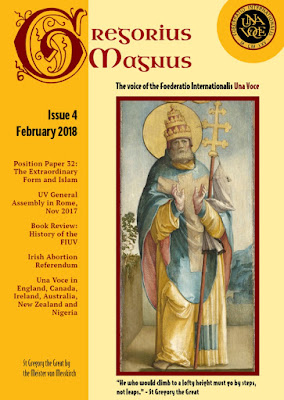The Latin Mass Society of New Zealand
The latest edition of Gregorius Magnus is available for download:
Gregorius Magnus is published by the Foederatio Internationalis Una
Voce. The FIUV is a lay movement within the Catholic Church, founded in Rome in 1965 and erected formally in Zürich in January 1967. The principal aims of the FIUV are to ensure that the Missale Romanum promulgated by Blessed Pope John XXIII in 1962 is maintained in the Church as one of the forms of liturgical celebration, to obtain freedom of use for all other Roman liturgical books enshrining “previous liturgical and disciplinary forms of the Latin tradition” and to safeguard and promote the use of Latin, Gregorian chant and sacred polyphony.
____________________________________________________________________
There is an interesting article on page 3:
THE LITURGICAL AFTERMATH OF THE SECOND VATICAN COUNCIL
The Right Honorable Lord Gill
I Introduction
It is an honour to be invited to give this talk to the Historical Association. My subject is
the liturgical aftermath of the Second Vatican Council. I begin by making it clear that I am
neither a historian nor a theologian nor a liturgist. The only qualifications that I have to
speak on the subject are that I am one of the dwindling band of Catholics who have lived
in two eras of the Catholic Church and that I have been personally involved in some of the
history that I will describe, as a Patron and life member of the Latin Mass Society, as the
Honorary President of Una Voce Scotland and as a former Counsellor of the International
Federation Una Voce.
First of all, what is this talk all about? It is not a piece of advocacy for or against the old rite or
the new rite of the Catholic Mass. The scheme of this talk is as follows:
I shall describe the introduction of the new rite and the profound changes that it caused. Then
I shall relate the history of the suppression of the old rite in the immediate aftermath of the
new rite. Then I shall describe the history that culminated in 2007 in the restoration of the old rite to parity with the new. Lastly, I shall review some of the consequences of the restoration in the life
of the Church. In doing so, I shall try to answer questions that may be of interest to historians: for example, why did Pope Paul VI and his bishops consider it expedient to suppress the old rite? What
strategic errors were made on both sides of the controversy? Was it inevitable that in the end the the rite would be restored? And if so, what circumstances made it so?
Continue at: http://www.fiuv.org/2019/10/gregorius-magnus-7-available.html

Interview with Cardinal Burke where he talks about the time before the Second Vatican Council, marriage and the Synod on the Family. Cardinal Burke also adds some personal insights, including about his devotion to St Joseph and St Therese of Lisieux who have helped him throughout his priesthood. He also mentioned the importance of St Therese’s “little way” and his devotion to the Rosary. Cardinal Burke enjoys the writings of Archbishop Fulton Sheen.